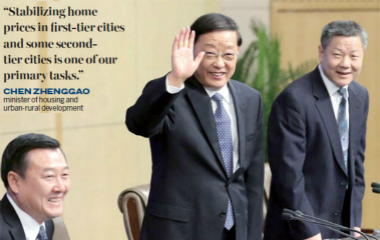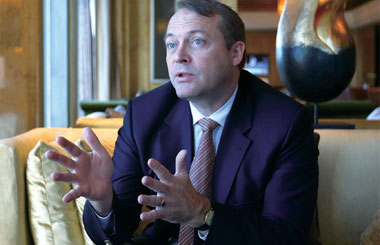Full text: Report on China's economic, social development plan
Updated: 2016-03-18 23:24
(Xinhua)
|
|||||||||
II. Guiding the New Normal and Applying the New Development Philosophy in 2016
This is the first year of the decisive stage in finishing building a moderately prosperous society in all respects and it is also an important year for surmounting the difficulties we face in the push toward structural reform. Effectively carrying out our economic work for this year is hugely important to ensuring that we can finish building a moderately prosperous society in all respects within the 13th Five-Year Plan Period (2016-2020).
1. General Requirements
We need to fully implement the guiding principles of the 18th National Party Congress and the third, fourth, and fifth plenary sessions of the 18th CPC Central Committee; follow the guidance of Deng Xiaoping Theory, the Theory of Three Represents, and the Scientific Outlook on Development; and fully put into practice the guidelines from General Secretary Xi Jinping' s major political addresses. We need to strengthen and improve the Party' s leadership over economic work; coordinate China's domestic and international efforts; act in accordance with the overall plan for promoting all-round socialist economic, political, cultural, social, and ecological development and the Four-Pronged Comprehensive Strategy*; and keep firmly in mind and put into practice the philosophy of innovative, coordinated, green, open, and shared development. We need to adapt ourselves to the new normal in China's economic development; adhere to the reform and opening up policy as well as the general principle of seeking progress while keeping performance stable; and continue to ensure steady economic growth, make structural adjustments, improve the standard of living, and guard against risks. We need to follow the general guidelines of keeping macro policies stable, industrial policies targeted, micro policies flexible, and reform policies practical, while also making sure social policies meet people's basic needs. The economy needs to continue operating within an appropriate range. We must be strategically prepared for a prolonged struggle, and tactically well prepared so that the challenges we may face can be overcome. We will intensify structural reform-as we increase aggregate demand by an appropriate degree, we will also work to cut overcapacity and excess inventory, deleverage, reduce costs, and strengthen points of weakness in order to improve the quality and efficiency of the supply system. Moreover, we will increase the effectiveness of investment, accelerate the fostering of new driving forces for development, upgrade and improve traditional comparative advantages, and strengthen the drivers for sustainable growth so that China's overall productivity improves and its economic and social development gets off to a good start for the 13th Five-Year Plan period.
2. Major Targets
Acting in line with the general requirements listed above and taking into account both what is necessary and what is possible, we have set forth the main targets for China's economic and social development in 2016 as follows:
- Ensuring steady and sound economic development
GDP is projected to grow by 6.5-7%. In setting this target, we have made the following considerations: First, such a rate is necessary for laying a good foundation for achieving the goal of finishing building a moderately prosperous society in all respects during the 13th Five-Year Plan period. To attain this goal by 2020, the economy needs to grow at an annual average rate of above 6.5% during the 13th Five-Year Plan period. Should the economy grow slower than 6.5% this year, growth rates for the next four years would have to be higher. This year's target of GDP growth between 6.5% and 7% will help us to gain the initiative and avoid increasing pressure for higher growth rates over the next few years. Second, this rate will help to effectively stimulate employment. In view of the correlation between economic growth and employment, a growth rate of between 6.5% and 7% should be able to create more than 10 million urban jobs. Third, such a rate is conducive to guiding market expectations and boosting confidence. As an elastic range of acceptable economic growth rates, this target is in line with China's potential growth rate and market expectations, which will allow it to play a positive role in helping to bolster confidence. At the same time, we are also aware that China will face a more complicated development environment this year and the slowdown in our economic growth has not yet been reversed. This means that stronger policies and greater efforts will be required if we are to achieve the targeted growth rate.
- Making further progress in achieving a better-quality, more efficient, upgraded economy
Both investment and consumption are projected to continue growing steadily, and the contribution of consumption toward economic growth is also projected to continue rising. The foundation of agriculture will be further strengthened, positive results will be achieved in industrial transformation and upgrading, the growth of strategic emerging industries will accelerate, and the contribution of the value-added of the service sector to GDP will continue to increase. Scientific and technological progress is expected to play a greater role in supporting economic growth and R&D spending as a percentage of GDP will be increased steadily. Energy consumption and carbon dioxide emissions per unit of GDP will be reduced by at least 3.4% and 3.9% respectively, water consumption per 10,000 yuan of GDP will fall by 5.1%; and chemical oxygen demand is projected to fall by 2%, ammonia nitrogen by 2%, sulfur dioxide emissions by 3%, and nitrogen oxide emissions by 3%. For those cities at prefectural level or above that fell short of the national standards for PM2.5 last year, their PM2.5 concentrations will be cut by 3% this year; and air quality in cities at prefectural level or above is expected to be good or excellent for 77% of the year. The proportion of surface water with a water quality rating of Grade III or higher will reach 66.5%, while the proportion of that lower than Grade V will be kept within 9.2%.
* The Four-Pronged Comprehensive Strategy refers to making comprehensive moves to finish building a moderately prosperous society in all respects, deepen reform, advance the law-based governance of China, and strengthen Party self-conduct.
- Keeping the overall price level basically stable
In setting a targeted increase of around 3% for CPI, we have taken the following into account: First, the continued impact from last year's CPI increase will be slightly greater than that of the year before. According to our forecast, the contribution of the previous year's CPI increase on the growth of CPI this year will be slightly higher than last year's 0.5%. Second, new factors will contribute to an increase in prices. Although weak demand will make a significant price rebound almost impossible, there will still be additional factors driving price increases: a rise in prices of services as a result of an increase in labor costs, the possibility of cyclical price fluctuations of a number of agricultural products, and the impact of further price reforms. Third, this target will help to guide market expectations. A target of higher price increases will be conducive to reducing expectations of deflation.
- Continuing to improve living standards
More than 10 million new urban jobs are expected to be created this year, and the registered urban unemployment rate will be kept within 4.5%. This will help to ensure that employment remains stable and will also provide leeway to address overcapacity, carry out enterprise mergers and reorganizations, and respond to the issue of hidden unemployment. Personal income will increase in step with economic growth and the income gap between urban and rural residents will continue to narrow. The number of rural residents living in poverty will be reduced by over 10 million and the percentage of the population registered as urban residents will increase by more than 1.3 percentage points. In order to ensure continuous improvement of the social security system, the overall management of social insurance accounts will be turned over to higher-level authorities, coverage will continue to be expanded, and the level of benefits will be increased appropriately. The coverage and equitable delivery of education, health care, culture, and other basic public services will continue to expand.
- Keeping the equilibrium in the balance of payments
The growth rate in the export of goods from China is projected to be faster than that of world trade, the volume of imports is expected to expand, and the proportion of trade in services in relation to the total volume of foreign trade will continue to increase. Foreign investment utilized by China will keep rising, and outbound direct investment is expected to grow rapidly.
3. Orientation of Macroeconomic Policies
Clear requirements were put forth at the Central Economic Work Conference held in Beijing last December for adapting to and guiding the new normal in economic development. In particular, the conference examined how the new normal should be viewed and handled, and in light of this, three approaches we must follow and ten areas of effort we need to highlight were emphasized. The new philosophy of innovative, coordinated, green, open, and shared development, put forward in the CPC Central Committee's Recommendations for the 13th Five-Year Plan for Economic and Social Development, will serve as a guide for economic and social development during the 13th Five-Year Plan period and beyond. To achieve the targets for economic and social development in 2016, we must keep firmly in mind the requirements for guiding the new normal in the economy and put into practice the new development philosophy. We need to channel greater energy into supply-side structural reform while increasing aggregate demand by an appropriate degree. We need to implement the general philosophy of keeping macro policies stable, industrial policies targeted, micro policies flexible, and reform policies practical, while also making sure social policies meet people's basic needs; at the same time, we need to make sure all policies are well coordinated and work together to create synergy.
- Keeping macro policies stable
We will ensure continuity in and make improvements to macroeconomic policies, strengthen range-based, targeted, and well-timed regulation, increase support for the real economy, and make sure the economy operates within an appropriate range.
On the one hand, we will increase the intensity of our proactive fiscal policy. The government deficit for 2016 is projected to be 2.18 trillion yuan nationwide, which represents a year-on-year increase of 560 billion yuan and a deficit-to-GDP ratio of 3%. Of this amount, the central government deficit will be 1.4 trillion yuan, and the remaining 780 billion yuan will come from the local government deficit. First, a scaled-up deficit in the short term will allow us to increase government spending and central budgetary investment by an appropriate amount, and more importantly to make up for the decrease in government revenue caused by tax and fee reductions, thus ensuring the government can fully meet all of its spending responsibilities. Second, we will optimize the structure of budgetary expenditures, make innovations in the way budgetary funds are used, put surplus budgetary funds to better use, and increase or reduce budgetary expenditures as necessary. Third, an appropriate increase will be allowed in the issuance of special bonds by local governments mainly to support land reserve, transportation, water conservancy, urban infrastructure, and other projects that will yield a certain degree of revenue. Local governments will continue to issue bonds to replace outstanding debts.
On the other hand, we will appropriately increase the flexibility of our prudent monetary policy. We will maintain reasonably ample liquidity and allow an appropriate increase in the aggregate financing of the economy. The M2 money supply is projected to grow by around 13% in 2016, roughly the same as last year. First, we will ensure a smooth transmission mechanism for monetary policy, lower financing costs for the real economy, ensure the financial sector serves the real economy more efficiently, and help solve the problem of financing being difficult and costly to obtain. Second, with the aim of expanding the issuance of bonds and equities as well as other financing channels, we will develop project revenue bonds, high-yield bonds, convertibles, extendable bonds, perpetual notes, and other hybrid securities. We will also raise the proportion of direct financing. Third, we will improve the market-based RMB exchange rate regime and continue to implement a managed floating exchange rate system, thereby allowing the RMB exchange rate to float more freely while also ensuring basic stability is maintained and the rate remains at an appropriate and balanced level. We will exert effective control over abnormal cross-border flow of capital.
While effectively implementing fiscal and monetary policies, we will coordinate the use of and increase compatibility between policies on industrial development, regional development, investment, consumption, and prices and strengthen counter-cyclical adjustments so as to create a stable macro environment for economic development and structural reform.
- Keeping industrial policies targeted
The direction of structural reform needs to be accurately determined; we need to stimulate increases in demand by making innovations on the supply side, and encourage the emergence of new areas of growth. First, we will continue to pursue innovation-driven development. In order to increase incentives for innovation and promote its practical application, we will implement action plans to encourage the commoditization and application of scientific and technological advances and carry out the intellectual property rights strategy, reform the system of property rights on scientific and technological advances, carry out preferential tax policies on equity and option rights, and improve the methods for distributing dividends and giving rewards. We will give full play to the role of entrepreneurship and innovation initiatives and the Internet Plus in pooling the wisdom and strength of the general public. Second, we will focus on invigorating existing resources. We will accelerate technological transformation and upgrading, revitalize existing industries and enterprises, take our industries to a new level, redouble efforts to develop the real economy, and encourage small and medium-sized enterprises to develop on the basis of innovation and transformation. Third, we will move faster to promote green development. We will encourage exploration and experimentation in promoting ecological progress and improve related institutions, and work hard to put in place an industrial system and spatial planning that are eco-friendly to spur on the development of green production and promote a green lifestyle.
- Keeping micro policies flexible
We will improve the market environment, invigorate businesses, and unlock the potential of consumers. First, with a focus on addressing the issue of the unsynchronized, uncoordinated, and incomplete delegation of powers to lower level governments, we will deepen reform of the government review and approval system, further relax restrictions on market access, and impose stronger and more effective oversight, thereby ensuring more efficient and convenient services for entrepreneurship and innovation, business investment and operations, and the general public. Second, in order to protect the property rights and legitimate interests of enterprises under all types of ownership, we will implement a review system to ensure fair competition, remove market barriers and local protectionism, and lift restrictions to ensure the free flow of commodities and factors of production, thus creating a relaxed investment and operating environment in which enterprises under all types of ownership can develop themselves through innovation. We will ensure that nongovernmental investments and investments by governments and SOEs are treated equally in terms of project review, financing services, fiscal and tax policies, and the use of land. Third, we will enhance our ability to provide effective supply and ensure it better corresponds to demand by creating new supply and improving the quality and efficiency of supply, which will ensure that the diversified and personalized demand of different consumer groups is fully satisfied.
- Keeping reform policies practicable
We will continue to raise the quality of our reform plans, improve reform implementation mechanisms, and make good use of pilot reforms, so that the results of reform are tangible and our people gain an increasingly greater sense of benefit. First, we will adhere to a problem-oriented approach. With a focus on resolving the main problems, we will channel our energy into carrying out important reforms that have a bearing on the overall situation, and we will rely on reforms to resolve the serious issues and problems that are hindering development. We will accelerate reform related to government review and approval; investment and financing; prices; SOEs; fiscal, tax, and financial systems; and social management. Second, we will strengthen coordination. In making reform more systemic, comprehensive, and balanced, we will ensure that major and critical reforms are guided by effective top-level planning, while also coordinating work on related reforms so as to create synergy. Third, we will spare no effort to ensure that reforms are fully implemented. We will work hard to address the issues of how to make sure that reform plans are tailored to reality, how to remove obstructions created during the adjustment of interests, and how to ensure the assumption of responsibilities for implementing reforms. We will give full rein to the initiative of community-level organizations and encourage local governments to explore which methods for implementing reform are best suited to local conditions, thereby ensuring that reform implementation is accurate, thorough, and effective.
- Making sure social policies meet people's basic needs
We will work hard to ensure the wellbeing of our people, giving full play to the role of the social safety net as a stabilizer. On the one hand, we will increase the supply of public services. Public services should be inclusive, equitable, and sustainable, and should guarantee the basic needs of the people. We will ensure everyone has access to basic necessities and basic public services. On the other hand, we will improve systems to ensure there is a cushion in place for those most in need. We will provide support to economically disadvantaged families based on their type of situation, increasing government funds for unemployment assistance and subsistence allowances, while ensuring that those poor families who are not supported by industry-led poverty-alleviation or employment assistance programs are covered by social security programs and have their basic needs met.
Today's Top News
China's latest GDP target is attainable: OECD Chief
What makes the middle class tick
One-stop app
EU to pitch migrant plan to Turkey
DPRK fires medium-range ballistic missile
Virgin Atlantic investigates abuse case
as story goes viral
Shanghai firm is latest Chinese investment in UK soccer business
Sino-UK documentary on Chinese New Year a hit
Hot Topics
Lunar probe , China growth forecasts, Emission rules get tougher, China seen through 'colored lens', International board,
Editor's Picks

|

|

|

|

|

|






